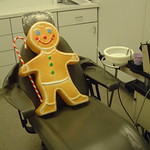Children Can See a Orthodontist As Early as 5 Years Old
Some children as early as 5 or 6 years of age may benefit from an orthodontic evaluation. Although treatment is unusual at this early age, some preventative treatment may be indicated.
By age 7, most children have a mix of baby (primary) and adult (permanent) teeth. Some common orthodontic problems seen in children can be traced to genetics, that is they may be inherited from their parents. Children may experience dental crowding, too much space between teeth, protruding teeth, and extra or missing teeth and sometimes jaw growth problems.
Other malocclusions (literally, “bad bite”) are acquired. In other words, they develop over time. They can be caused by thumb or finger-sucking, mouth breathing, dental disease, abnormal swallowing, poor dental hygiene, the early or late loss of baby teeth, accidents or poor nutrition. Trauma and other medical conditions such as birth defects may contribute to orthodontic problems as well. Sometimes an inherited malocclusion is complicated by an acquired problem. Whatever the cause, the orthodontist is usually able to treat most conditions successfully.
An Orthodontist for children is trained to spot subtle problems with jaw growth and emerging teeth while some baby teeth are still present. The advantage for patients of early detection of orthodontic problems is that some problems may be easier to correct if they are found and treated early. Waiting until all the permanent teeth have come in, or until facial growth is nearly complete, may make correction of some problems more difficult. For these reasons, the AAO recommends that all children get a check-up with an orthodontist no later than age 7. While your child’s teeth may appear straight to you, there could be a problem that only an orthodontist can detect. Of course, the check-up may reveal that your child’s bite is fine, and that is comforting news.
Some children as early as 5 or 6 years of age may benefit from an orthodontic evaluation. Although treatment is unusual at this early age, some preventative treatment may be indicated.
By age 7, most children have a mix of baby (primary) and adult (permanent) teeth. Some common orthodontic problems seen in children can be traced to genetics, that is they may be inherited from their parents. Children may experience dental crowding, too much space between teeth, protruding teeth, and extra or missing teeth and sometimes jaw growth problems.
Other malocclusions (literally, “bad bite”) are acquired. In other words, they develop over time. They can be caused by thumb or finger-sucking, mouth breathing, dental disease, abnormal swallowing, poor dental hygiene, the early or late loss of baby teeth, accidents or poor nutrition. Trauma and other medical conditions such as birth defects may contribute to orthodontic problems as well. Sometimes an inherited malocclusion is complicated by an acquired problem. Whatever the cause, the orthodontist is usually able to treat most conditions successfully.
An Orthodontist for children is trained to spot subtle problems with jaw growth and emerging teeth while some baby teeth are still present. The advantage for patients of early detection of orthodontic problems is that some problems may be easier to correct if they are found and treated early. Waiting until all the permanent teeth have come in, or until facial growth is nearly complete, may make correction of some problems more difficult. For these reasons, the AAO recommends that all children get a check-up with an orthodontist no later than age 7. While your child’s teeth may appear straight to you, there could be a problem that only an orthodontist can detect. Of course, the check-up may reveal that your child’s bite is fine, and that is comforting news.
